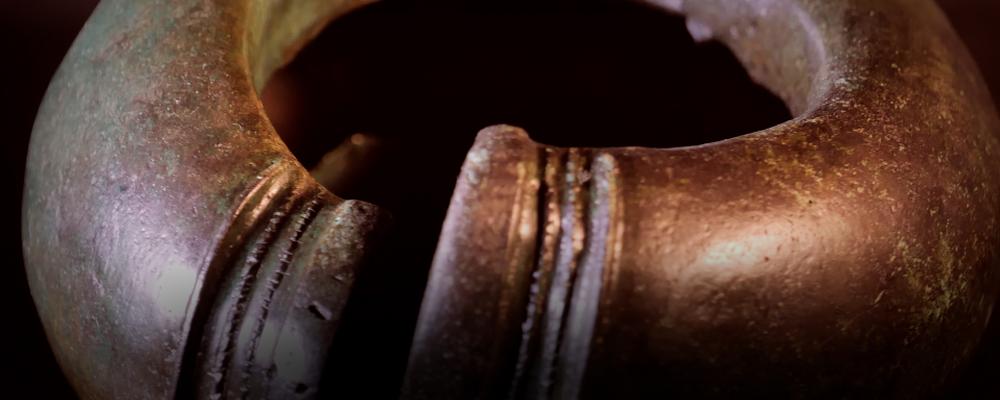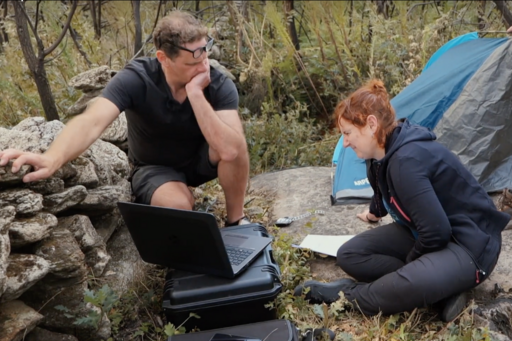
- Home
- News and events
- Find news
- Bronze hoard in Alingsås led archaeologists to Spain
Bronze hoard in Alingsås led archaeologists to Spain
The story behind the bronze objects discovered in spring 2021 by an orienteerer in a forest near Alingsås is finally becoming clear.
Analyses by archaeologists at the University of Gothenburg indicate that one third of the objects are based on copper originating from Spain. Furthermore, the location of the discovery – the hills around Alingsås – may have been an important ritual landscape during the Bronze Age.
It is one of the largest finds of Late Bronze Age objects ever recovered in Sweden, and includes necklaces, pins for fastening garments, spiral ornaments, and large arm- and foot rings. Analyses have now shown that the copper in the objects originates from Spain.
“We’ve taken samples from some of the objects and sent them for analysis in a laboratory in the Basque region, where we conduct a lot of analyses. The results indicate quite unequivocally that the copper is actually from the Iberian peninsula, in Spain," says Johan Ling, professor of archaeology at the University of Gothenburg.
Documentary on SVT
The documentary Bronsskattens hemlighet (Secret of the bronze hoard) is now available on SVTplay, and invites viewers to follow the University of Gothenburg archaeologists in their quest for answers.
Who could have deposited these objects here, and what was the social positions of these people in the Bronze Age society? Why were these objects placed , in the hilly area south of Alingsås? And perhaps the most important question of all: Did these objects belong to one person or a certain group in society.

Anyone attempting to make bronze requires copper and tin. However, tin does not exist in Sweden and copper was not mined here during the Bronze Age. In search of answers, last autumn archaeologist Johan Ling and his team of researchers travelled to Spain and Galicia, to one of areas in Europe that are richest in copper and tin, to examine the rock carvings (called petroglyphs) in the region. The team found petroglyphs in Spain that were similar to those in Sweden.
“Interestingly, there are petroglyphs in Galicia that depict Scandinavian ships characteristic of the period, and exactly the same period that the Alingsås find is from,” Johan Ling explains.
“There is much that indicates that groups from Scandinavia could have been here to make these carvings, because they are so incredibly similar. Not just in terms of style, but also in the carving technique and how they are depicted on flat rocks.”
Ritual landscape in Alingsås?
But a question we cannot answer with these analyses is why these objects were deposited just here, near Alingsås. The terrain slopes steeply and access is difficult.
“The location has nothing to do with any settlements. What is interesting is that on the other side of this hilly area, another major hoard of bronze objects was discovered, but from a different period. So perhaps this hill was used as a space for sacrifices in different phases of the Bronze Age, and that it can be seen as a ritual landscape,” says Johan Ling.
Today, the area is densely covered by forest, but there were no spruce forests in Sweden during the Bronze Age. Having made observations at the site, the archaeologists now believe that the place was a man-made stone construction that may have been highly visible in the Bronze Age landscape.
“The location would, thus, have acquired a special significance and may have been used for depositions and associated rituals . Everyone, serf and peasant alike, would have been aware that it lay up here. You might almost think of it like a bronze statue.”
Archaeologists and researchers looking for answers
Bronsskattens hemlighet (Secret of the bronze hoard), was created by documentary filmmaker Mikael Agaton and was broadcast on the program Vetenskapen värld (World of Science) on Monday, 6 February at 8 p.m. It is also available on SVTplay.
The documentary features archaeologists Johan Ling, Jonas Paulsson, Magnus Artursson and Kristian Kristiansen from the Department of Historical Studies at the University of Gothenburg, and Jonathan Westin from the Gothenburg Research Infrastructure in Digital Humanities (GRIDH), along with Faculty of Humanities’ honorary doctor and cultural geographer Pär Connelid. In addition, Fleming Kaul (National Museum of Denmark, Copenhagen), Ana M. S. Bettencourt (University of Minho), and Marta Díaz-Guardamino (Durham University) are featured.
